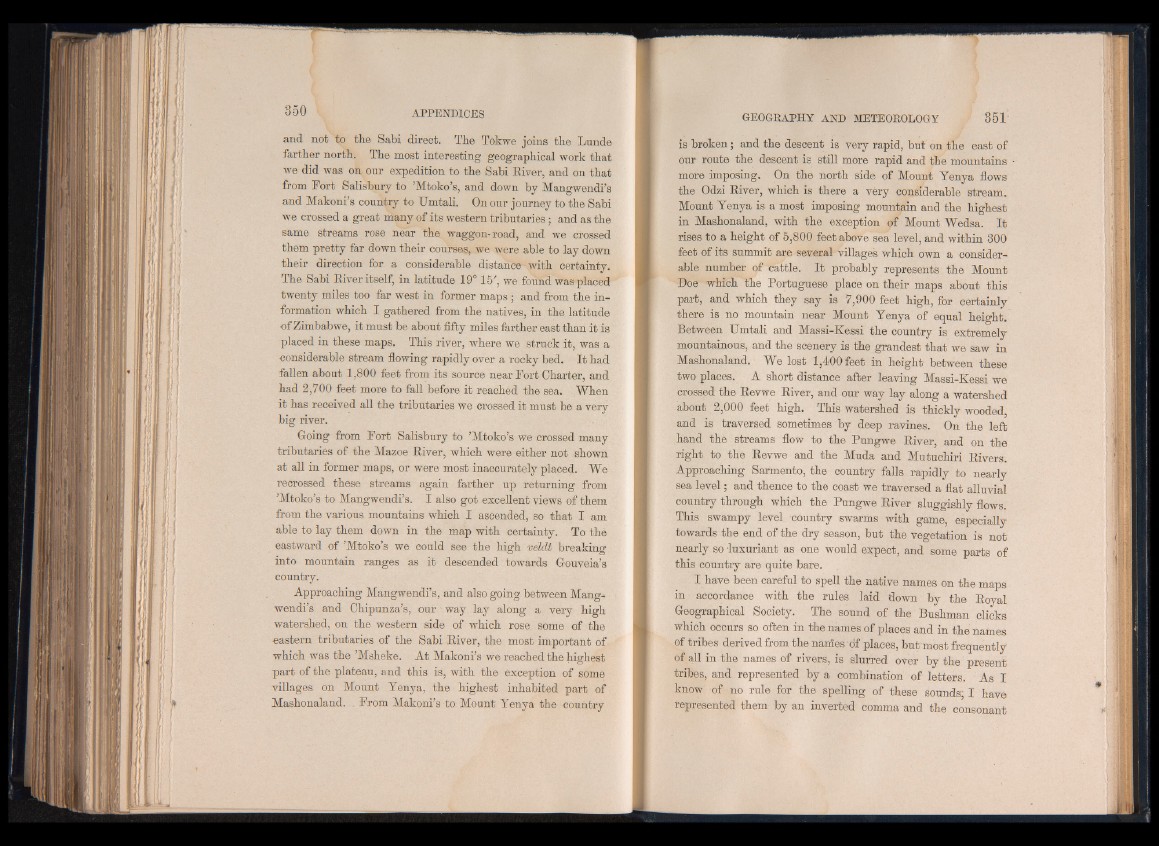
and not to the Sabi direct. The Tokwe joins the Lunde
farther north. The most interesting geographical work that
we did was on our expedition to the Sabi River, and on that
from Fort Salisbury to ’Mtoko’s, and down by Mangwendi’s
and Makoni’s country to Umtali. On our journey to the Sabi
we crossed a great many of its western tributaries; and as the
same streams rose near the waggon-road, and we crossed
them pretty far down their courses, we were able to lay down
their direction for a considerable distance with certainty.
The Sabi River itself, in latitude 19° 15', we found was placed
twenty miles too far west in former maps ; and from the information
which I gathered from the natives, in the latitude
o f Zimbabwe, it must be about fifty miles farther east than it is
placed in these maps. This river, where we struck it, was a
■considerable stream flowing rapidly over a rocky bed. It had
fallen about 1,800 feet from its source near Fort Charter, and
had 2,700 feet more to fall before it reached the sea. When
it has received all the tributaries we crossed it must be a very
big river.
Going from Fort Salisbury to ’Mtoko’s we crossed many
tributaries of the Mazoe River, which were either not shown
at all in former maps, or were most inaccurately placed. We
recrossed these streams again farther up returning from
’Mtoko’s to Mangwendi’s. I also got excellent views of them
from the various mountains which I ascended, so that I am
able to lay them down in the map with certainty. To the
eastward of ’Mtoko’s we could see the high veldt breaking
into mountain ranges as it descended towards Gouveia’s
country.
Approaching Mangwendi’s, and also going between Mangwendi’s
and Chipunza’s, o u rw a y lay along a very high
watershed, on the western side of which rose, some of the
eastern tributaries of the Sabi River, the most important of
which was the ’Msheke. At Makoni’s we reached the highest
part of the plateau, and this is, with the exception of some
villages on Mount Yenya, the highest inhabited part of
Mashonaland. . From Makoni’s to Mount Yenya the country
is broken; and the descent is very rapid, but on the east of
our route the descent is still more rapid and the mountains
more imposing. On the north side of Mount Yenya flows
the Odzi River, which is there a very considerable stream.
Mount Yenya is a most imposing mountain and the highest
in Mashonaland, with the exception of Mount Wedsa. It
rises to a height of 5,800 feet above sea level, and within 300
feet of its summit are several villages which own a considerable
number of cattle. It probably represents the Mount
Doe which the Portuguese place on their maps about this
part, and which they say is 7,900 feet high, for certainly
there is no mountain near Mount Yenya of equal height.
Between Umtali and Massi-Kessi the country is extremely
mountainous, and the scenery is the grandest that we saw in
Mashonaland. We lost 1,400 feet in height between these
two places. A short distance after leaving Massi-Kessi we
crossed the Revwe River, and our way lay along a watershed
about 2,000 feet high. This watershed is thickly wooded,
and is traversed sometimes by deep ravines. On the left
hand the streams flow to the Pungwe River, and on the
right to the Revwe and the Muda and Mutuchiri Rivers.
Approaching Sarmento, the country falls rapidly to nearly
sea lev e l; and thence to the coast we traversed a flat alluvial
country through which the Pungwe River sluggishly flows.
This swampy level country swarms with game, especially
towards the end of the dry season, but the vegetation is not
nearly so luxuriant as one would expect, and some parts of
this country are quite bare.
I have been careful to spell the native names on the maps
in accordance with the rules laid down by the Royal
Geographical Society. The sound of the Bushman clicks
which occurs so often in the names of places and in the names
of tribes derived from the names df places, but most frequently
of all in the names of rivers, is slurred over by the present
tribes, and represented by a combination of letters. As I
know of no rule for the spelling of these sounds, I have
represented them by an inverted comma and the consonant